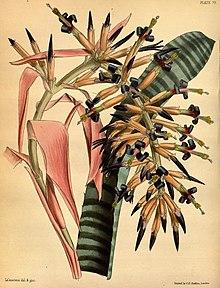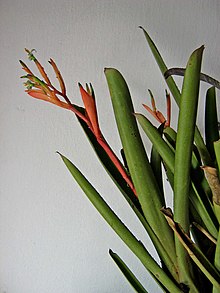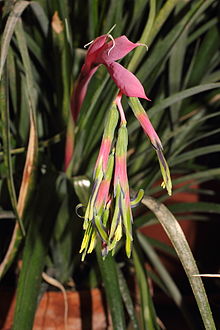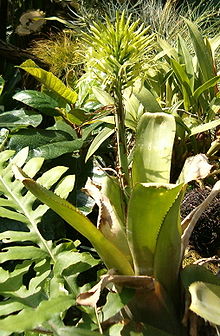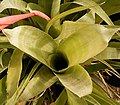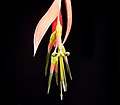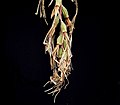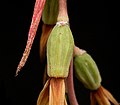
Inflorescence of Billbergia nutans , their varieties have long been among the easy-care houseplants
-
Billbergia acreana
H.Luther : It occurs only in the Brazilian state of Acre .
-
Billbergia alfonsi-joannis Reitz : It thrives as an epiphyte in forests at altitudes of around 700 meters only in the Brazilian state of Santa Catarina .
-
Billbergia amoena (Loddiges) Lindl. : It thrives terrestrially, lithophytically and epiphytically. It occurs with some subtaxa in Brazil:
-
Billbergia amoena (Loddiges) Lindl. var. amoena (Syn .: Billbergia chlorocyanea de Vriese , Billbergia discolor (Loisel.) Beer , Billbergia laevis Van Tieghem , Billbergia pallens hort. ex Rivière , Billbergia pallescens C. Koch & CDBouché , Billbergia pallida (Ker Gawl.) Beer , Billbergia pallidiflora hort. ex E. Morren , Billbergia speciosa sensu Baker non Thunb. , Billbergia variegata (Vellozo) Beer , Billbergia wiotiana de Jonghe ex Mez , Billbergia wacketii Mez ): It thrives terrestrially, lithophytically and epiphytically at altitudes from 0 to 1050 meters.
-
Billbergia amoena var. Carnea E. Pereira : It occurs only in the Brazilian state of Minas Gerais .
-
Billbergia amoena var. Cylindracea E. Pereira : It occurs only in the Brazilian state of Rio de Janeiro .
-
Billbergia amoena var. Flavescens Reitz : It occurs only in the Brazilian state of Rio de Janeiro.
-
Billbergia amoena var. Minor (Antoine & Beer) LBSm. (Syn .: Billbergia binoti R. Gerard , Pitcairnia decora Linden ex Beer , Billbergia decora hortus ex Beer , Billbergia pyramidalis var. Minor Antoine & Beer ex Beer , Billbergia speciosa Thunb. Non Baker , Billbergia thunbergiana hort. Ex Baker , Billbergia variegata E. Morren ): It occurs at altitudes of around 1300 meters only in the Brazilian state of Minas Gerais.
-
Billbergia amoena var. Robertiana E. Pereira & Leme : It occurs only in the Brazilian state of Espírito Santo .
-
Billbergia amoena var. Stolonifera E. Pereira & Moutinho : It occurs only in the Brazilian state of Rio de Janeiro.
-
Billbergia amoena var. Stolonifera f. viridiflora E. Pereira & Moutinho : It occurs only in the Brazilian state of Rio de Janeiro.
-
Billbergia amoena var. Viridis L.B.Sm. : It occurs only in the Brazilian states of Espirito Santo and Rio de Janeiro at altitudes of up to 1400 meters.
-
Billbergia brachysiphon L.B.Sm. : There are three varieties:
-
Billbergia brachysiphon L.B.Sm. var. brachysiphon : It thrives terrestrially or epiphytically in dry forests or rainforests at altitudes of about 425 meters in the Brazilian states of Amapá , Pará and Mato Grosso .
-
Billbergia brachysiphon var. Breviflora H.Luther : It occurs only in Zamora-Chinchipe at altitudes of about 900 meters in Ecuador.
-
Billbergia brachysiphon var. Paraensis L.B.Smith : It grows epiphytically in the Colombian Caqueta and in the Brazilian states of Acre, Amapá and Pará.
-
Billbergia bradeana L.B.Sm. : It thrives terrestrially in forests at altitudes of about 1800 meters only in the Brazilian state of Espírito Santo.
-
Billbergia brasiliensis L.B.Sm. (Syn .: Billbergia ianthina hort. Ex E. Morren , Billbergia kuhlmannii L.B.Sm. , Billbergia leopoldii (hort. Verschaff. Ex Lem. ) Linden ex Houllet , Billbergia mohammadii R.Vásquez & Ibisch , Billbergia nuptialis hort. Makoy ex E. Morren , Billbergia velascana Cárdenas ): It thrives terrestrially, lithophytically or epiphytically in the Brazilian states of Santa Catarina and Rio de Janeiro.
-
Billbergia cardenasii L.B.Sm. : It occurs in Bolivia .
-
Billbergia castelensis E.Pereira : It grows epiphytic only in the Brazilian state of Espírito Santo.
-
Billbergia chiapensis Matuda : It grows epiphytically at altitudes of around 1200 meters only in the Mexican state of Chiapas.
-
Billbergia chlorantha L.B.Sm. : It occurs only in the Brazilian state of Espírito Santo.
-
Billbergia chlorosticta hoard. Saunders (Syn .: Billbergia saundersii hort. Bull ex K.Koch , Billbergia saundersii hort. Bull ex Dombrain ): It is said to come from Brazil and was first described using a cultivated specimen.
-
Billbergia × claudioi Leme : It is a nature hybrid of Billbergia distachia var. Distachia × Billbergia vittata , which thrives lithophytically only in the Brazilian state of Rio de Janeiro.
-
Billbergia cylindrostachya Mez (Syn .: Billbergia maxima C. Chev. ): It occurs only in the Brazilian state of Rio de Janeiro.
-
Billbergia dasilvae Leme : It only grows epiphytically in the Brazilian state of Rondônia .
-
Billbergia debilis E. Pereira : It occurs only in the Brazilian state of Bahia.
-
Billbergia decipiens Pereira & Reitz : It only thrives on rocks in the Brazilian state of Rio de Janeiro.
-
Billbergia decora Poepp. & Endl. (Syn .: Billbergia baraquiniana Lem. , Billbergia boliviensis Baker ): It thrives epiphytically in forests at altitudes of 135 to 1350 meters in Peru , Bolivia and Brazil.
-
Billbergia distachia (Vellozo) Mez (Syn .: Billbergia distaceia (Vellozo) Mez ): There are four varieties in Brazil:
-
Billbergia distachia var. Concolor Reitz : It grows epiphytically in forests in the Brazilian states of Rio de Janeiro and Santa Catarina.
-
Billbergia distachia (Vellozo) Mez var. Distachia (Syn .: Billbergia bakeri sensu Lindm. Non E. Morren , Billbergia burchellii Baker , Billbergia caespitosa Lindm. , Billbergia ensifolia Baker , Billbergia reguliana Mez ): It grows epiphytically and terrestrially in coastal bushes (Restinga ) and in the rainforest at altitudes from 0 to 1800 meters in Brazil.
-
Billbergia distachia var. Maculata Reitz : It occurs only in the Brazilian state of Santa Catarina.
-
Billbergia distachia var. Straussiana (Wittmack) LBSmith (Syn .: Billbergia bakeri var. Straussiana Wittm. , Billbergia bakeri E. Morren non Lindm. , Billbergia pallescens sensu Baker , Billbergia amoena var. Cernua Beer ex E. Morren ): She only comes in the Brazilian state of Santa Catarina.
-
Billbergia eloiseae L.B.Smith & RWRead : It was first described in 1983 using a cultivated specimen that originated in Colombia.
-
Billbergia euphemiae E. Morren : There are four varieties in eastern Brazil:
-
Billbergia euphemiae E. Morren var. Euphemiae (Syn .: Billbergia repens hort. Ex E. Morren ): It thrives lithophytically or epiphytically in forests in the Brazilian states from Bahia to Rio de Janeiro.
-
Billbergia euphemiae var. Nudiflora L.B.Sm. : It occurs in the Brazilian states of Minas Gerais and Espírito Santo.
-
Billbergia euphemiae var. Purpurea M.B.Foster : It thrives in full sun on rocks only in the Brazilian state of Espírito Santo.
-
Billbergia euphemiae var. Saundersioides L.B.Sm. : It occurs only in the Brazilian state of Bahia.
-
Billbergia formosa Ule : It occurs only in the Peruvian region of Loreto.
-
Billbergia fosteriana L.B.Sm. : It occurs only in the Brazilian state of Bahia.
-
Billbergia horrida rule : There are two varieties:
-
Billbergia horrida Rule var. Horrida : It thrives epiphytically at altitudes of about 300 meters in Brazil.
-
Billbergia horrida var. Tigrina hortus ex Baker : It was first described on the basis of a cultivated specimen and little is known about it.
-
Billbergia incarnata (Ruiz & Pavón) Schultes f. : It occurs only in the Peruvian region of Huanuco.
-
Billbergia iridifolia (Nees & Martius) Lindl. : There are two varieties in eastern Brazil:
-
Billbergia iridifolia var. Concolor L.B.Sm. : It only thrives lithophytically in the Brazilian state of Espírito Santo.
-
Billbergia iridifolia (Nees & Martius) Lindl. var. iridifolia (Syn .: Billbergia iridifolia . var iridifolia hort ex. E.Morren , Billbergia iridiflora hort ex. E.Morren ): It thrives lithophytic and epiphytic at altitudes from 0 to 1140 meters in the Brazilian states of Bahia and Rio de Janeiro .
-
Billbergia issingiana T. Krömer & E. Gross : It wasfirst describedin 2001 in The Bromeliad . So far it has only been found as an epiphyte in the "Yungas Forest" at an altitude of about 1300 meters only in the province of Sud Yungas in the Bolivian department of La Paz .
-
Billbergia jandebrabanderi R.Vásquez & Ibisch : It wasfirst describedin 2003 in The Bromeliad . It thrives epiphytically in large groups at altitudes of 300 to 500 meters in Bolivia in Santa Cruz and Cochabamba.
-
Billbergia kautskyana E.Pereira : This endemic thrives at an altitude of around 800 meters only in the Brazilian state of Espírito Santo.
-
Billbergia laxiflora L.B.Sm. : It thrives epiphytically in rainforests at altitudes of about 650 meters only in the Brazilian state of Espírito Santo.
-
Billbergia leptopoda L.B.Sm. : It thrives epiphytically and terrestrially at an altitude of about 765 meters in the Brazilian states of Espírito Santo and Minas Gerais.
-
Billbergia lietzei E. Morren : There are two varieties in the Brazilian state of Rio de Janeiro:
-
Billbergia lietzei var. Chlorantha E.Morren
-
Billbergia lietzei E. Morren var. Lietzei
-
Billbergia lymanii E. Pereira & Leme : There are two varieties in eastern Brazil:
-
Billbergia lymanii var. Angustifolia E. Pereira & Leme : It occurs only in the Brazilian state of Rio de Janeiro.
-
Billbergia lymanii E. Pereira & Leme var. Lymanii : It occurs only in the Brazilian state of Espírito Santo.
-
Billbergia macracantha E. Pereira : It only grows epiphytically in the Brazilian state of Rio de Janeiro.
-
Billbergia macrocalyx Hook. (Syn .: Billbergia quintutiana hort. Makoy ex Baker , Billbergia quintusiana hort. Makoy ex Wittm. ): It occurs in the Brazilian states of Bahia and Minas Gerais.
-
Billbergia macrolepis L.B.Sm. (Syn .: Billbergia pallidiflora sensu Mez non Liebmann , Billbergia richterana E.Pereira , Billbergia richterana var. Bicolor E.Pereira ): It thrives epiphytically at altitudes of 60 to 200 meters in Panama , Costa Rica , Colombia , Venezuela and perhaps Brazil.
-
Billbergia magnifica Mez : There are two varieties:
-
Billbergia magnifica var. Acutisepala Hassler : It thrives on trees in "Campo Serrado" in Paraguay, only Esperanza.
-
Billbergia magnifica Mez var. Magnifica : It thrives epiphytically in thickets and forests in Brazil and Paraguay.
-
Billbergia manarae Steyermark : This endemic thrives on rocks at altitudes of around 1000 meters in Venezuela only in the Federal District.
-
Billbergia matogrossensis Leme : It wasfirst describedin 2014 from the Brazilian state of Mato Grosso . It thrives epiphytically in the cerrado vegetation at altitudes of about 400 meters.
-
Billbergia meyeri Mez (Syn .: Billbergia leucantha Hoehne ): It thrives epiphytically, sometimes in the leaf sheaths of palm trees, at altitudes of about 400 meters in Bolivia and Brazil.
-
Billbergia microlepis L.B.Sm. : This endemic thrives at altitudes of 850 to 950 meters in Bolivia only in La Paz.
-
Billbergia minarum L.B.Sm. : There are two varieties in eastern Brazil:
-
Billbergia minarum L.B.Sm. var. minarum : It occurs in the Brazilian states of Espírito Santo and Minas Gerais.
-
Billbergia minarum var. Viridiflora E. Pereira & Leme : It thrives terrestrially at altitudes of around 700 meters only in the Brazilian state of Espírito Santo.
-
Billbergia morelii Brongn. (Syn .: Billbergia dubia hort. Ex Beer , Billbergia glymiana de Vriese , Billbergia moreliana Brongn. , Billbergia pulcherrima C. Koch & CDBouché , Billbergia wetherelli Hook. ): It thrives epiphytically at altitudes of 480 to 800 meters in Brazil.
-
Billbergia nana E. Pereira : It occurs only in the Brazilian state of Espírito Santo.
-
Billbergia nutans H. Wendland ex rule : There are three varieties:
-
Billbergia nutans H.Wendland ex Regel var. Nutans (Syn .: Billbergia bonplandiana Gaudich ex Mez. , Billbergia linearifolia Baker , Billbergia minuta Mez ): It grows epiphytic in forests at altitudes of 700 to 1000 meters in Brazil, Paraguay, Uruguay and Argentina .
-
Billbergia nutans var. Schimperiana (Wittmack) Baker (Syn .: Billbergia amandae W. Weber , Billbergia schimperiana Wittm. Ex Baker ): It occurs in Brazil and Paraguay.
-
Billbergia nutans var. Striata Reitz : It occurs only in the Brazilian state of Rio Grande do Sul .
-
Billbergia oxysepala Mez (Syn .: Billbergia oxypetala Ule ): It occurs only in the Brazilian state of Acre .
-
Billbergia pallidiflora Liebmann (Syn .: Billbergia mexicana Mez ): It thrives epiphytically and lithophytically at altitudes of 100 to 1400 meters from Mexico via Guatemala to Nicaragua.
-
Billbergia pohliana Mez : It occurs only in the Brazilian state of Minas Gerais.
-
Billbergia porteana Brongniart ex Beer : It thrives epiphytically and lithophytically at altitudes of 800 to 1300 meters in Brazil and Paraguay.
-
Billbergia pyramidalis (Sims) Lindl. (Syn .: Billbergia pyramidalis var. Vernicosa Pereira , Billbergia pyramidalis var. Striata M.B.Foster ): There are three varieties:
-
Billbergia pyramidalis var. Concolor L.B.Sm. ( Billbergia thyrsoidea sensu Lindl. , Billbergia paxtonii Beer ): It is only known from culture.
-
Billbergia pyramidalis var. Lutea Leme & W.Weber : This endemic occurs only in the District of Rio das Ostras in the Brazilian state of Rio de Janeiro.
-
Billbergia pyramidalis (Sims) Lindl. var. pyramidalis (Syn .: Billbergia thyrsoidea . Mart f. ex Schult. & Schult. , Billbergia bicolor Lodd. , Billbergia atrorosea Drapiez , Billbergia loddigesii Steud. , Billbergia rhodocyanea hort. ex K.Koch & CDBouché , Billbergia thyrsoides de Jonghe , Billbergia splendida Lem. , Billbergia croyana de Jonghe ex Lem. , Billbergia miniatorosea Lem. , Billbergia fastuosa ( C. Morren ) Beer , Billbergia punicea Beer , Billbergia longifolia C. Koch & CDBouché , Billbergia atropurpurea hort, ex E. Morren , Billbergia croyana Lem. Ex E. Morren , Billbergia farinosa K. Koch ex E. Morren , Billbergia peruviana hort. Ex E. Morren , Billbergia setosa hort. Makoy ex E. Morren , Billbergia splendida Lem. Ex E. Morren , Billbergia tricolor hort. Ex E.Morren , Billbergia speciosa Carrière , Billbergia schultesiana Baker , Billbergia thyrsiflora hort. ex Gentil , Billbergia pyramidalis var. croyana E.Morren , Billbergia pyramidalis var. farinosa E.Morren , Billbergia pyramidalis var. zonata E.Morren (de Briese) ): It thrives terrestrially at altitudes of 500 to 1700 meters in Brazil; there are finds in Venezuela and Caribbean islands, but this is arguably not their natural home.
-
Billbergia reichardtii Wawra : It grows epiphytically in open forests in the Brazilian states of Espírito Santo and Minas Gerais.
-
Billbergia robert-readii E. Gross & Rauh : This endemic thrives epiphytically in rainforests at an altitude of about 600 meters in the southern Peruvian region of Madre de Dios .
-
Billbergia rosea Beer (Syn .: Billbergia granulosa Brongn. Ex Baker , Billbergia venezuelana Mez ): It occurs in Venezuela and on the island of Trinindad.
-
Billbergia rubicunda Mez : It was first described on the basis of a cultivated specimen in the Schönbrunn Botanical Garden, which may come from Suriname .
-
Billbergia rupestris L.B.Sm. : It thrives epiphytically at an altitude of about 230 meters in Brazil and Colombia.
-
Billbergia sanderiana E. Morren (Syn .: Billbergia amoena sensu LBSm. Non (Loddiges) Lindl. ): It thrives epiphytically in the Brazilian states of Espírito Santo, Rio de Janeiro and Minas Gerais.
-
Billbergia saundersii hort. W.Bull ex Dombrain (Syn .: Billbergia saundersii hort. W.Bull ex K.Koch , Billbergia chlorosticta Saunders , Billbergia debilis E.Pereira ): It comes from the Brazilian state of Bahia.
-
Billbergia seidelii L.B.Sm. & Reitz : It only occurs in the Brazilian state of Rio de Janeiro.
-
Billbergia speciosa Thunb. (Syn .: Billbergia elegans Martius ex Schultes f. , Billbergia amoena var. Penduliflora M.B.Foster ): It thrives terrestrial, epiphytic lithophytic or at altitudes up to 1,240 meters only in the Brazilian state of Minas Gerais.
-
Billbergia stenopetala Harms : This endemic thrives on trees in the rainforest only in the Peruvian region of Loreto .
-
Billbergia tessmannii Harms : This endemic thrives epiphytically in the rainforest at an altitude of about 100 meters only in the Peruvian region of Loreto.
-
Billbergia tweedieana Baker : There are two varieties in Brazil:
-
Billbergia tweedieana var. Latisepala L.B.Sm. : It only thrives lithophytically in the Brazilian state of Rio de Janeiro.
-
Billbergia tweedieana Baker var. Tweedieana : It only thrives lithophytically in the Brazilian states of Espírito Santo and Rio de Janeiro.
-
Billbergia violacea Beer (Syn .: Billbergia commixta C. Koch , Billbergia macrostachya Brongn. Ex Baker , Billbergia stipulata Brongn. Ex Baker , Billbergia stipularis Durand & Jackson ): It thrives epiphytically at altitudes of about 350 meters in Guyana and Brazil.
-
Billbergia viridiflora H. Wendland : It thrives epiphytically and lithophytically at altitudes of up to 150 meters from Mexico via Guatemala to Belize .
-
Billbergia vittata Brongniart (Syn .: Billbergia zonata hort. Makoy , Billbergia more liana Henfrey , Billbergia rohaniana de Briese , Billbergia amabilis Beer , Billbergia leopoldii hort. Belg. Ex C.Koch , Billbergia excellens Miq. , Bromelia rohaniana Walp. , Billbergia domingosmartinsis E .Gross , Billbergia vittata var. amabilis E.Morren , Billbergia vittata var. rohani Wittm. ): It grows epiphytic and lithophytic at altitudes of 200-1400 meters in the Brazilian states of Minas Gerais, Espírito Santo and Rio de Janeiro.
-
Billbergia zebrina (Herbert) Lindl. (Syn .: Billbergia farinosa Lindl. & Hoffmanns , Billbergia stipulate Brongn. Ex K. Koch , Billbergia bicolor hort. Ex E. Morren , Billbergia canterae André ): It grows epiphytically at altitudes of 15 to 30 meters in Brazil, Paraguay , Uruguay as well as Argentina.
|

